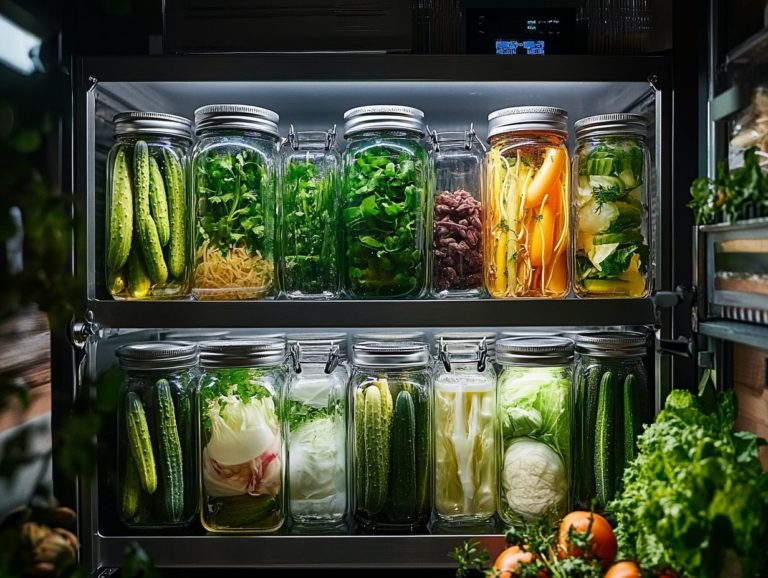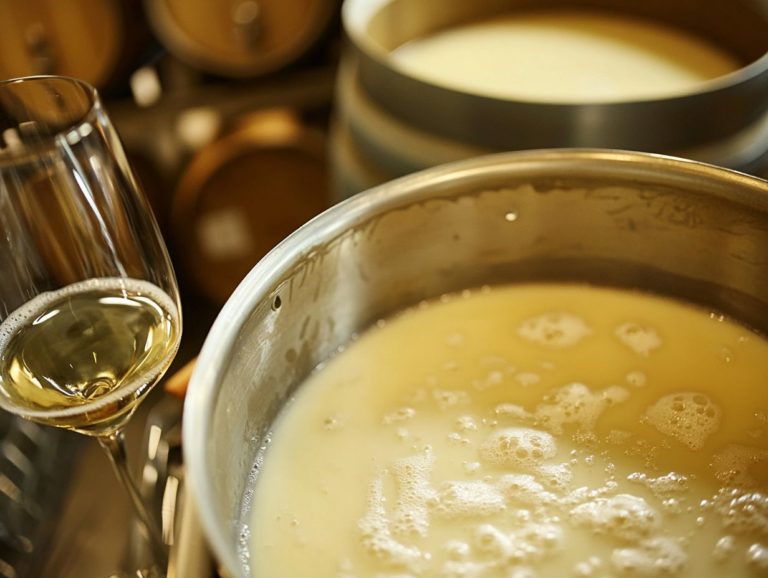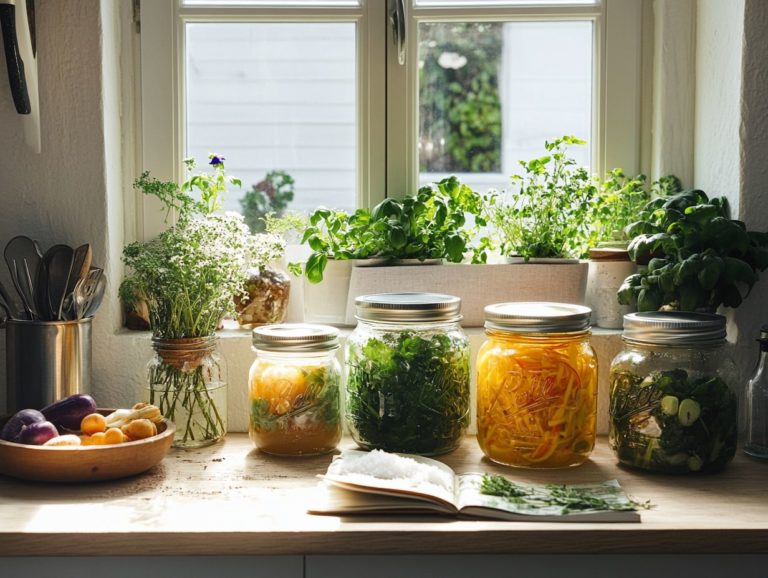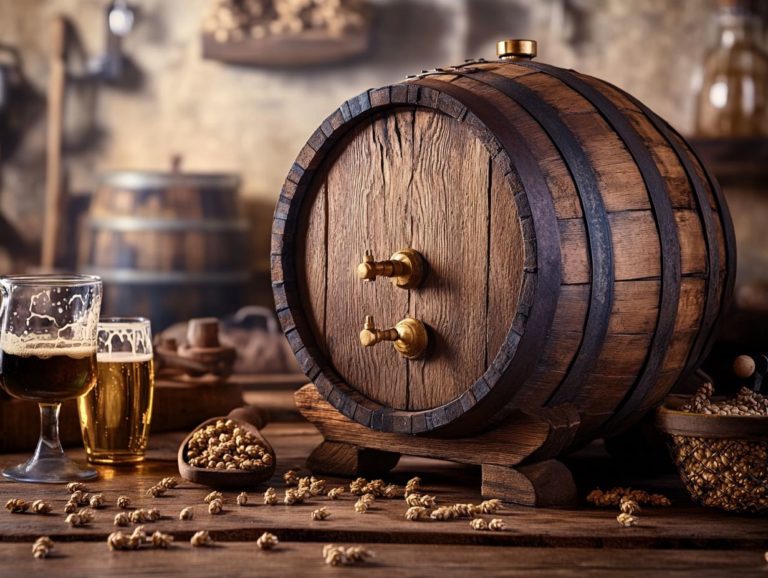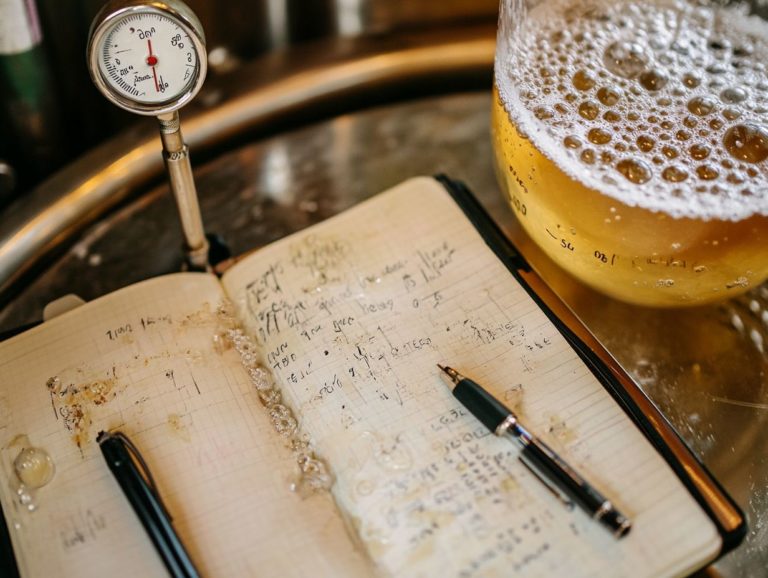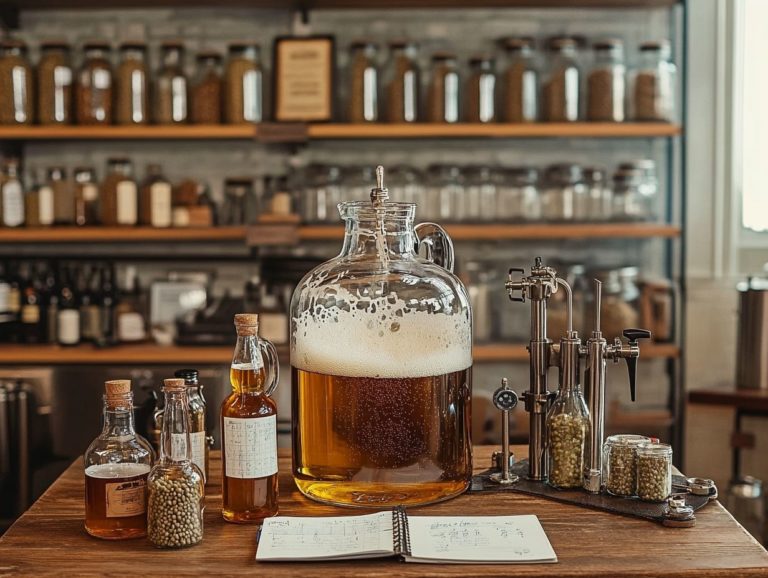What to Do if Fermentation Stops Early
Fermentation is an intriguing process that transforms ingredients into something remarkably new, yet it can sometimes take an unexpected turn, especially in the world of homebrewing.
Have you ever found yourself in a situation where fermentation appears to come to a standstill, a phenomenon often referred to as stuck fermentation? It can be both frustrating and perplexing.
In this discussion, you will delve into the essential elements of fermentation, uncover the common reasons it may stall prematurely, and learn how to identify and resolve these issues.
By the time you finish, you will possess the knowledge and confidence to ensure your fermentation endeavors are a resounding success!
Contents
Key Takeaways:
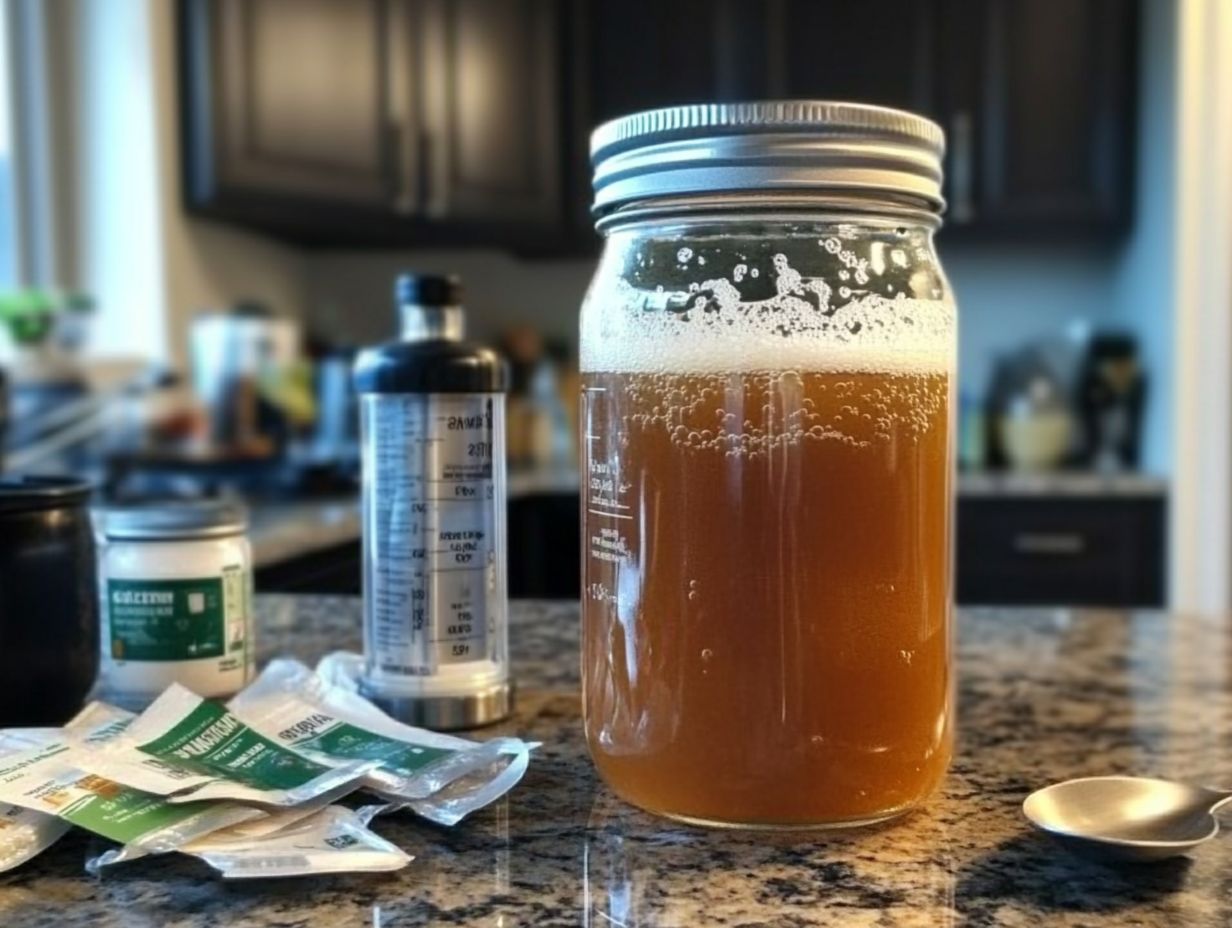
- Check for nutrient deficiency, temperature control, contamination, oxygen levels, and pH levels in your fermentation area to identify why fermentation stopped early.
- Early fermentation stoppage can lead to beer spoilage, decreased nutritional value, and off-flavors.
- To fix early fermentation stoppage, add nutrients, adjust temperature, check for contamination, increase oxygen levels, and balance pH levels.
What Is Fermentation?
Fermentation is a fascinating biochemical process that transforms sugars into alcohol and carbon dioxide (CO2), all thanks to the diligent work of microorganisms, primarily yeast. This process plays a vital role in numerous applications, particularly in home winemaking and beer brewing, where selecting high-quality yeast is essential for crafting the flavors and alcohol content you desire.
Your fermentation journey typically starts with the preparation of a wort, which involves using malt extract alongside other carefully chosen ingredients, often in a fermentation tank. To ensure your efforts yield the best results, you’ll need to meticulously control fermentation temperature and various other factors throughout the process.
Why Does Fermentation Stop Early?
Understanding the reasons behind early stoppage is essential to safeguard the integrity of your final product. This is especially important in the world of home winemaking and brewing, as it can profoundly influence the taste, alcohol content, and overall quality of your creation. Common culprits behind fermentation troubles include insufficient nutrients, lackluster yeast vitality, and poor temperature control all factors that can derail your brewing process if not carefully monitored.
Causes of Early Fermentation Stoppage
One of the most significant reasons you may encounter early fermentation stoppage is a lack of essential nutrients, such as nitrogen and vitamins, which your yeast needs for healthy fermentation activity and vitality. Without adequate nutrients, the yeast can struggle to ferment sugars effectively, leading to a range of fermentation problems and potential failures especially in home winemaking and brewing, where nutrient composition can vary widely.
Identifying nutrient deficiencies is crucial for you as a brewer aiming for successful fermentation. Signs like sluggish fermentation rates or off-flavors often point to an imbalance in nutrient levels.
To tackle these issues, you can add specific substances like diammonium phosphate (DAP) and Yeast Activator to provide the necessary nitrogen for yeast. By integrating these nutritional enhancements, you can optimize your fermentation techniques, ensuring healthier yeast populations and ultimately a superior product.
Continued education in brewing practices emphasizes the importance of nutrient management, making it an essential focus whether you’re just starting out or have years of experience under your belt. Unlock the secrets to a perfect brew!
Start your brewing journey today with these tips!
2. Inadequate Temperature
Inadequate temperature control is a critical factor that can lead to early fermentation stoppage, as yeast is particularly sensitive to temperature fluctuations throughout the fermentation process. Each yeast strain has its ideal temperature range for fermentation, and stepping outside this range can hinder its activity or even kill the yeast, resulting in incomplete fermentation and undesirable flavors.
To promote healthy yeast behavior and maximize fermentation efficiency, it s essential for you to maintain fermentation temperatures within that optimal range. Warmer temperatures may speed up yeast activity, leading to faster fermentation, but they also increase the risk of producing off-flavors and esters that could alter the character of your final product.
On the other hand, cooler temperatures can slow fermentation, which might yield a cleaner profile but also extend the fermentation time, potentially delaying the high krausen stage.
It s crucial for you to monitor temperature closely and utilize various techniques such as temperature-controlled fermentation vessels and insulation methods to ensure consistent conditions. By doing so, you ultimately enhance the quality and flavor profile of your finished brew.
3. Contamination
Contamination from unwanted bacteria or wild yeast can spell disaster for your fermentation process, jeopardizing both the quality and safety of your final product. These pesky contaminants can introduce off-flavors and spoilage compounds, creating fermentation headaches that are particularly daunting for home winemakers and those brewing beer without proper sterilization techniques.
To effectively tackle these challenges, it s essential to implement best practices for sanitation throughout your brewing journey, such as those recommended by the Pink Boots Society.
This means thoroughly cleaning all equipment and surfaces before use and opting for sanitizing agents that are proven to obliterate potential spoilage organisms.
Quality yeast management is another key player in this game; by selecting robust yeast strains that are less prone to contamination, you significantly increase your odds of successful fermentation. By consistently maintaining a clean brewing environment and ensuring that all your ingredients are free from unwanted microbes, you can safeguard the integrity of your batches and relish the delightful flavors in your finished products.
4. Insufficient Oxygen
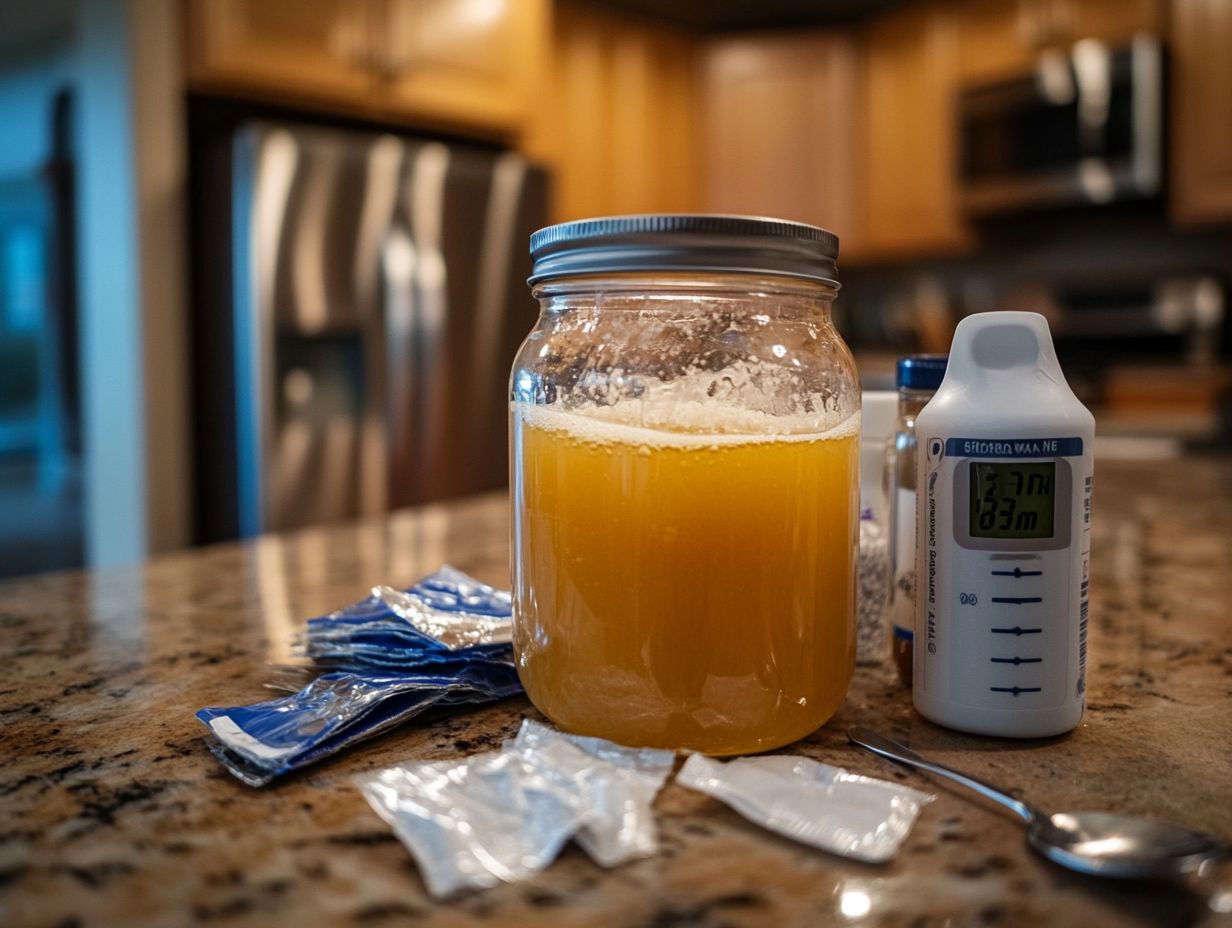
Insufficient oxygen levels during the initial fermentation stages can be a significant barrier to yeast vitality, potentially leading to fermentation failure and subpar fermentation activity.
Yeast, after all, requires a certain amount of oxygen to build cell membranes and reproduce effectively. Proper yeast management means ensuring that adequate oxygen is present at the moment of pitching and understanding the critical stages of fermentation where oxygen levels should be consistently monitored and controlled.
To effectively aerate your wort before fermentation, consider employing techniques such as shaking the fermenter or utilizing an aquarium pump paired with an aeration stone. Additionally, during the yeast pitching stage, ensuring adequate oxygen can make a significant difference.
This initial oxygenation is not just a minor detail; it s crucial for supporting yeast growth and overall health.
As a brewer, it s essential to take precautions against oxidation once fermentation is in progress. As yeast moves into its primary growth phase, its need for oxygen diminishes dramatically. In fact, exposing it to oxygen during this stage can result in off-flavors and spoilage.
Maintaining a closed fermentation system and diligently monitoring fermentation temperatures are vital practices in brewing education, as taught by institutions like Northern Brewer University.
These steps are key to preserving the integrity of your beer while ensuring robust fermentation activity.
5. Incorrect pH Levels
Incorrect pH levels can dramatically influence your fermentation process, as yeast thrives within a specific pH range. If the pH strays too high or too low, it can hinder yeast activity and result in subpar fermentation outcomes. That’s why, as a home winemaker or brewer, it’s essential to keep a watchful eye on pH levels and make adjustments as needed throughout the fermentation stages.
Understanding how to accurately measure pH during fermentation, using tools like a hydrometer, can significantly impact the quality of your final product. To achieve optimal fermentation readings, regularly use pH meters or test strips, ensuring that the levels hover around 3.0 to 3.5 for most wines or between 4.0 and 5.0 for certain beers. If adjustments are necessary, use food-grade acids to lower pH, while alkaline substances like potassium bicarbonate can raise it.
Maintaining the right pH not only enhances yeast performance but also influences flavors and aromas, resulting in a more balanced beverage. This is especially important in alcohol fermentation to achieve the desired quality.
In essence, diligent pH management is a crucial component of effective yeast management and is vital for achieving the fermentation outcomes you desire.
How to Identify if Fermentation Has Stopped Early?
It s vital to spot if fermentation has stopped early to ensure your brew or wine turns out perfectly. Regular fermentation readings can help in this regard. This can be accomplished by meticulously monitoring fermentation readings with tools such as a hydrometer.
By consistently measuring specific gravity with a hydrometer, you can ascertain whether the fermentation process has reached its conclusion or if further troubleshooting is necessary to resolve any potential issues.
What Are the Risks of Early Fermentation Stoppage?
Early fermentation stoppage presents several risks that can compromise your final product’s integrity. These include potential spoilage, off flavors, and a reduction in nutritional value.
Whether you’re a home winemaker or a commercial brewer, grasping these risks is essential. They can greatly influence the quality and marketability of your wine and beer, paving the way for increased fermentation challenges in the future.
1. Spoilage
Spoilage presents one of the most immediate risks when fermentation stops unexpectedly, as unwanted bacteria can multiply and create unpleasant flavors and aromas that undermine the integrity of your beverage. This is especially critical in the brewing process, where spoilage can lead to substantial losses and tarnish your reputation as a brewer.
When fermentation comes to an abrupt halt, various spoilage issues may arise. For instance, the growth of lactic acid bacteria can lead to a souring effect in your beer, while oxidation can introduce stale flavors. In the realm of wine production, undesirable yeast species might seize control, causing volatile acidity a condition where the wine becomes sour due to unwanted bacteria that can ruin a meticulously crafted vintage.
To avert these potential disasters, you must prioritize strict sanitation practices, diligently monitor fermentation temperatures, and effectively manage yeast health. Employ fining agents and utilize appropriate storage techniques to help ensure that your final product remains stable, preserving both quality and flavor while protecting the esteemed reputation of your beverage.
2. Decreased Nutritional Value
Fermentation plays a crucial role in enhancing the nutritional content of both wine and beer. A decrease in nutritional value is a significant risk if fermentation stops prematurely.
Fermentation does more than just convert simple sugars into alcohol; it also fosters the development of essential vitamins, minerals, and antioxidants vital for overall health. For example, B vitamins, especially B6 and B12, are synthesized during fermentation, supporting energy metabolism and brain function.
If the fermentation process is interrupted too soon, you may find that polyphenols, which are abundant in fermented drinks, are significantly reduced. Early stoppage can also compromise essential amino acids, ultimately affecting the overall protein profile of the final product.
Therefore, understanding the dynamics of fermentation is crucial for you as a brewer or winemaker who aims to preserve the nutritional quality of your beverages. This highlights the necessity of brewing education, particularly in tackling common fermentation issues that can impede optimal nutrient production.
3. Off Flavors
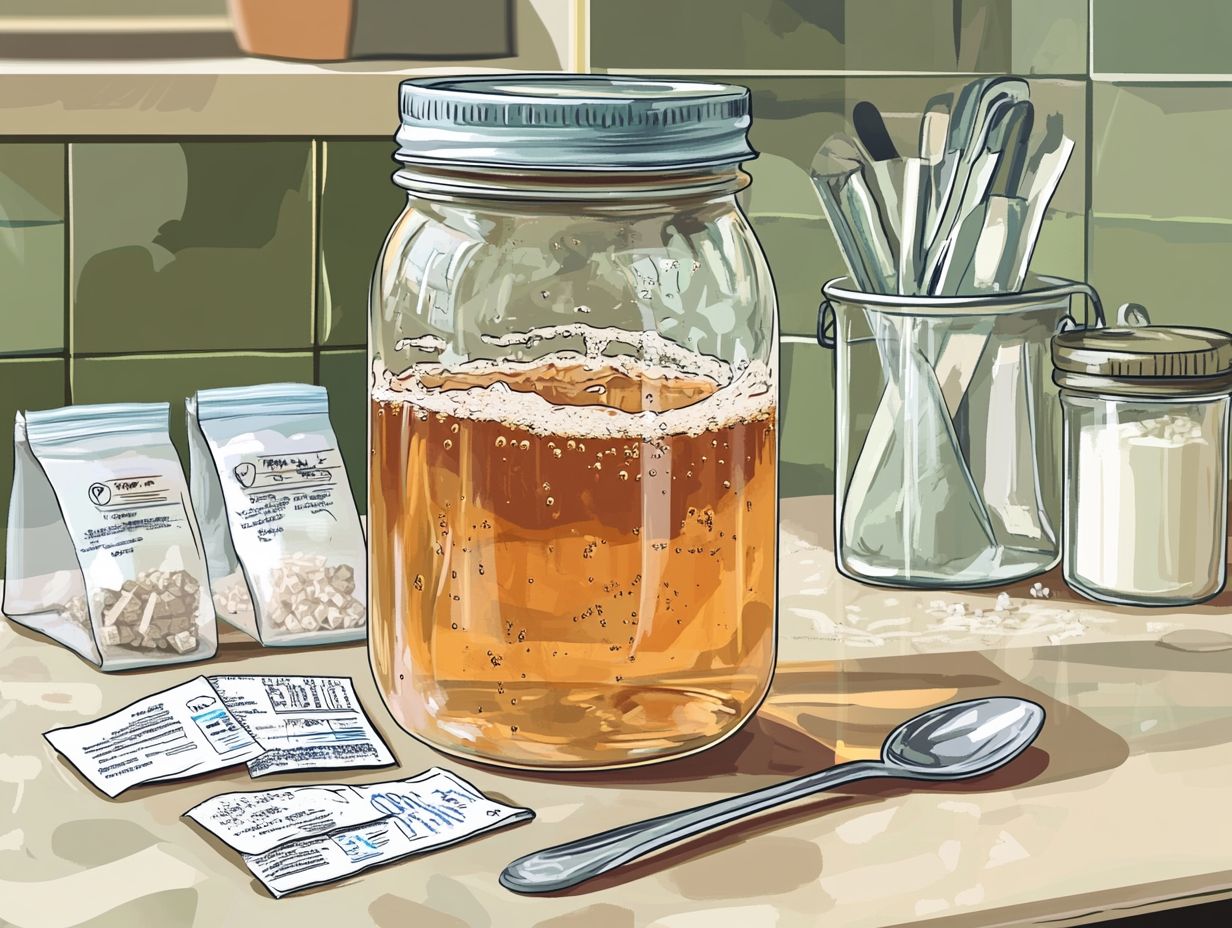
Off flavors that stem from early fermentation stoppage can severely compromise the taste of your wine and beer. They often leave behind unpleasant remnants of fermentation failure.
These undesirable flavors may emerge from unwanted bacteria or inadequate yeast management during the fermentation process. The impact of these fermentation issues can be profound, frequently resulting in sourness or vinegar-like notes that detract significantly from the flavor profile you intended to achieve.
When fermentation is halted prematurely, the presence of unfermented sugars can create a cloying sweetness that overshadows the complexity of your brew. You may also encounter off flavors such as diacetyl, which lends a buttery aroma, and phenolic compounds that can impart a medicinal or plastic-like taste.
Understanding the power of high-quality yeast and proper fermentation practices is your secret weapon to brewing success! By doing so, you can greatly minimize these challenges, ultimately enhancing the enjoyment and satisfaction of your consumers.
How to Fix Early Fermentation Stoppage?
Addressing early fermentation stoppage demands a meticulous approach to fermentation troubleshooting. This encompasses a thorough evaluation of nutrients, temperature regulation, and yeast management practices.
By grasping the underlying causes of fermentation challenges, you can employ effective strategies that not only restore fermentation activity but also help you achieve the results you desire in your winemaking or brewing endeavors.
1. Add Nutrients
One of the most effective strategies to tackle early fermentation stoppage is to add nutrients directly to your fermentation tank. This provides your yeast with the essential building blocks it needs to keep thriving.
By utilizing high-quality yeast nutrients, you can breathe new life into sluggish fermentation and enhance your overall brewing results. These nutrients typically include nitrogen sources like diammonium phosphate (DAP), which play a vital role in yeast growth and metabolism.
Additionally, yeast energizers that contain a blend of vitamins and amino acids can further aid in revitalizing the fermentation process. Act quickly! When you integrate these additives at the first signs of a fermentation slowdown, you can achieve remarkable results.
It s wise to dissolve nutrient supplements in water before adding them to the tank, as this promotes even distribution and minimizes any stress on the yeast. By thoughtfully selecting and implementing these fermentation techniques, you can effectively support yeast health and achieve a more successful fermentation.
2. Adjust Temperature
Adjusting the fermentation temperature is vital for restarting fermentation, as yeast thrives within specific temperature ranges. By carefully watching and adjusting the temperature, you can create an ideal environment for yeast to flourish and successfully complete the fermentation process.
It’s crucial to grasp the significance of gradual temperature changes. Sudden fluctuations can stress the yeast, leading to subpar performance or even stalled fermentation. Each yeast strain has its own preferred temperature range some favor cooler conditions, while others excel in warmer settings.
For example, ales generally thrive between 65 F and 75 F, whereas lagers tend to flourish in a cooler range of 45 F to 55 F. By keeping a vigilant eye on fermentation activity, you can gain invaluable insights into the yeast’s health. This allows for timely adjustments that enhance fermentation efficiency to its fullest potential.
3. Check for Contamination
Checking for contamination is essential when you encounter early fermentation stoppage. Unwanted bacteria or wild yeast can wreak havoc on fermentation outcomes and lead to outright failure. By adhering to strict hygiene practices and inspecting your brewing equipment, you can significantly minimize the risk of contamination.
Identifying signs of contamination early is crucial for effective fermentation management. Keep an eye out for abnormal smells, unexpected flavors, or unusual color changes during the fermentation process.
Establishing a routine to clean and sanitize your fermenters, tools, and storage vessels is key to creating a healthy environment for your yeast. By utilizing high-quality yeast strains and closely monitoring fermentation conditions like temperature and pH levels you can optimize yeast performance.
By taking these proactive measures, you not only safeguard your batches but also elevate the overall quality and consistency of your crafted beverages.
4. Increase Oxygen Levels
Increasing oxygen levels during the early stages of fermentation can truly revitalize your yeast vitality and stimulate fermentation activity, particularly if oxygen deficiency has hindered your initial efforts. By employing proper aeration techniques, you can enhance this process while avoiding the risks of oxidation later on.
In brewing, introducing oxygen at the right moment is essential; it amplifies the metabolic processes of the yeast, enabling it to flourish and convert sugars into alcohol efficiently. Shake the fermenter vigorously, utilize an aeration stone, or splash the wort to effectively increase the dissolved oxygen content. Timing is everything aim to aerate right after pitching the yeast to ensure that yeast can soak up the oxygen when it is most active.
This initial infusion of oxygen not only bolsters yeast health but also sets the stage for vigorous fermentation, ultimately resulting in a cleaner flavor profile and an overall enhanced quality of your final product.
5. Balance pH Levels
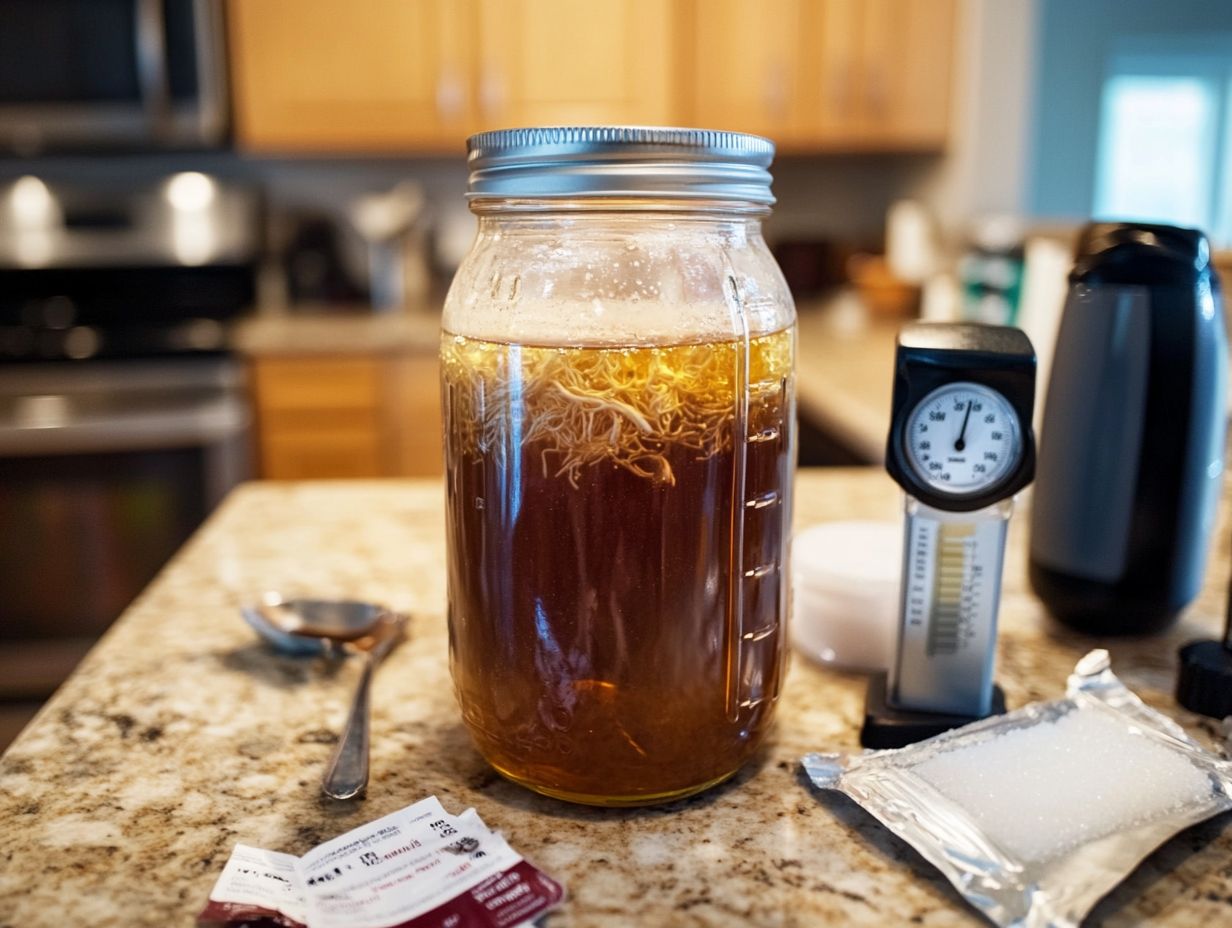
Balancing pH levels is a crucial step in addressing early fermentation stoppage. Yeast flourishes within a specific pH range. By adjusting these levels appropriately, you can enhance yeast performance and foster a successful fermentation process, effectively mitigating potential issues that arise from an unbalanced pH.
To achieve optimal results, many brewers rely on pH meters for real-time monitoring, enabling immediate adjustments as fermentation progresses. Regular readings offer valuable insights into how pH influences yeast activity, fermentation speed, and the flavor of your final product. Tools like hydrometers and precise fermentation metrics also help in maintaining optimal conditions.
If the pH drops too low, sluggish fermentation can occur, resulting in undesirable off-flavors. On the flip side, if the pH rises excessively, it can impede yeast growth and stability, leading to potential fermentation failure.
Using acids or bases, such as lactic acid, sodium bicarbonate, or sodium bisulfate, is an effective way to adjust these levels, ensuring that your yeast has an environment conducive to vigorous fermentation. Understanding the intricate relationship between pH and yeast behavior is important for getting the right flavor and clarity in your brew. Homebrewing enthusiasts often use these techniques to achieve professional-quality results.
Frequently Asked Questions
For additional brewing education and tips, resources from Northern Brewer University and experts like Kelly F., Ed Kraus, and Tara Nurin can provide valuable insights.
Discover more about the brewing process, yeast vitality, and fermentation techniques to enhance your brewing skills.
What can cause fermentation to stop early?
Temperature control is critical to avoid fermentation stopping early. It’s a common issue in brewing beer or wine.
Fermentation can stop early due to several reasons, such as insufficient yeast, low nutrient levels, temperature fluctuations, or contamination. This can be frustrating for home winemakers and brewers alike.
How can I tell if fermentation has stopped?
High krausen is a visible sign of active fermentation. When it subsides, it’s often a clue that fermentation is slowing down.
You can tell if fermentation has stopped by checking the specific gravity of the liquid using a hydrometer. If it remains the same for several days, fermentation has likely stopped. Monitoring the gravity is crucial in diagnosing fermentation problems.
What should I do if my fermentation stops early?
Using good yeast pitching practices and ensuring proper oxygen levels can help restart a stuck fermentation.
If your fermentation stops early, try adding more yeast, increasing nutrient levels, or maintaining a consistent temperature to restart the process. Yeast energizer and proper yeast management can also help.
Can I still save a batch if fermentation stops early?
Ensure your fermentation area is clean and free from bacteria to prevent beer spoilage when trying to save a batch.
Yes, you may be able to save a batch if fermentation stops early. You can try restarting the process or bottling the batch as is, depending on the specific circumstances. Using a secondary fermenter can sometimes resolve issues related to fermentation failure.
How can I prevent fermentation from stopping early?
Using quality yeast and malt extract can help maintain a consistent fermentation temperature and prevent fermentation from stopping early.
To prevent fermentation from stopping early, use enough yeast, maintain proper nutrient levels, and keep a consistent temperature throughout the process. Proper temperature control and the use of a yeast starter can go a long way in preventing stuck fermentation.
Is it safe to consume a batch that stopped fermenting early?
Using potassium sorbate can prevent unwanted fermentation activity, ensuring your batch is safe to consume.
In most cases, it is safe to consume a batch that stopped fermenting early. However, if there are any signs of contamination, it is best to discard the batch to avoid potential health risks. Always follow proper fermentation guidelines to ensure safety and quality.

